Ukraine conflict: Why is east hit by conflict?
- Published
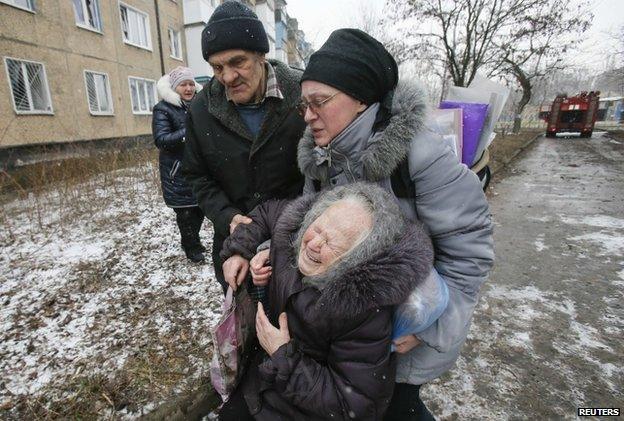
Civilians have been caught in the middle as the intensity of violence increases
Pro-Russian rebels have entered the strategic town of Debaltseve in eastern Ukraine after heavy fighting - despite a ceasefire agreement.
Most of the Ukrainian government forces have pulled out of the town, a key transport hub.
A new truce deal was reached on 12 February through international mediation, in an attempt to stop the fighting spiralling out of control.
What prompted the flare-up in a conflict that has cost more than 5,600 lives and few saw coming?

How did eastern Ukraine return to full-scale conflict?
Fighting started in April 2014 and raged for months until Ukraine and the separatists came to a deal on 5 September to halt the violence and free prisoners.
But the ceasefire never held entirely. Both sides used the relative lull to build up their forces and for months the rebels tried to seize Donetsk airport, a strategic and symbolic asset, from government forces.

Ukrainian forces finally succumbed to a rebel onslaught against the strategic town of Debaltseve
With the start of 2015, a new rebel push began and by 22 January the airport was in their hands.
Donetsk airport - coveted prize
Violence flared the length of the September ceasefire line and casualties mounted:
Civilians killed by shells and rockets in rebel-held cities of Donetsk and Luhansk
Thirty people killed in Ukrainian port city of Mariupol, in artillery attack said by observers to come from rebel-held areas
Rebels besiege major road and rail hub of Debaltseve, where thousands of Ukrainian troops are based, leading to a withdrawal on 18 February
Rebels fire rockets at civilian areas in Kramatorsk, government-controlled city and military HQ far beyond conflict zone
Ultra-nationalist volunteer battalion linked to the government seizes villages from rebels outside Mariupol in south


Will the new ceasefire work?
The deal struck on 12 February in Minsk by the leaders of Germany, France, Ukraine and Russia is similar to the old one, but tries to tackle some of its shortcomings.
For the rebels, the new ceasefire line is the same as the old one, so they lose some of the territory they have gained. But government forces must pull back from the current front-line, and territory they have lost since January is confirmed as lost.
But a key omission from the deal was Debaltseve - because the sides could not agree about who would end up controlling it.
Even if the bloodshed stops and the guns fall silent, the future status of the rebel-held areas of Donetsk and Luhansk remains unclear.
Ukraine is adamant there is no new deal on autonomy for the rebel areas, only decentralisation - so that could anger the rebels.
And it is difficult imagining the rebels agreeing to hold elections under Ukrainian law in their areas, just as it is seeing Ukraine getting back control of its eastern border.
Both conditions are part of the 13-point plan agreed in Minsk.

Hundreds of civilians have had to flee the rebel advance

So what is in the 13-point plan?
Immediate ceasefire from 0000 on 15 February (2200 GMT on 14 February)
Buffer zone separating heavy weapons of both sides. Before, big guns had to pull back by 15km (9 miles)
Now, minimum buffer zone of 50km for 100mm artillery and up to 140km for rockets
Effective verification by international security group OSCE
Amnesty and release of all hostages and illegally detained people by fifth day of pull-out
Restoration of government pensions and other welfare payments for civilians in the east
Full Ukrainian control over eastern border, after local elections under Ukrainian law and a constitutional deal on future of Donetsk and Luhansk by end of 2015

Ukraine's war: The human cost
5,665 people killed and 13,961 wounded in eastern Ukraine
Fatalities include 298 people on Malaysia Airlines flight MH17 shot down on 17 July
5.2 million people estimated to be living in conflict areas
978,482 internally displaced people within Ukraine, including 119,832 children
600,000 fled to neighbouring countries, of whom more than 400,000 have gone to Russia
Source: Figures from UN reports, 6 and 17 February, external

Why did the September ceasefire break down?
Each side accused the other of tearing up the peace deal.
For the government, it was the rebels' decision to hold their own local elections in November 2014, in defiance of the Kiev authorities.
The separatists were then angered by the government decision to scrap the special status of their two regions, Donetsk and Luhansk.
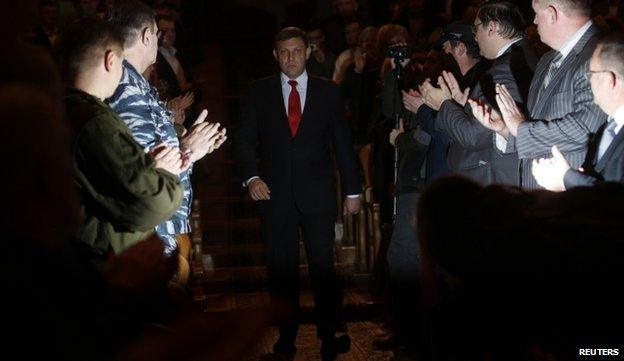
Alexander Zakharchenko was declared head of the self-declared Donetsk People's Republic after a disputed vote
Among the terms of the truce were a commitment to pull back heavy guns from the front line by at least 15km (9 miles), a release of prisoners and an agreement for international observers to monitor the truce and a buffer zone on the Ukrainian border with Russia.
Ukraine would also grant wider self-rule to Donetsk and Luhansk.
Both sides used the ceasefire to rearm, but the rebels now appear to have better quality tanks and weapons than the government.
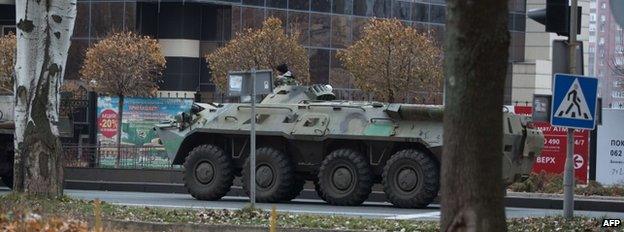
Nato said the unmarked armoured vehicles were from Russia

Who has the upper hand now?
The rebels certainly have made big gains, with the capture of Donetsk airport and the assault on Debaltseve.
The airport gave them a strategic asset a few miles from the centre of Donetsk city, their biggest stronghold.
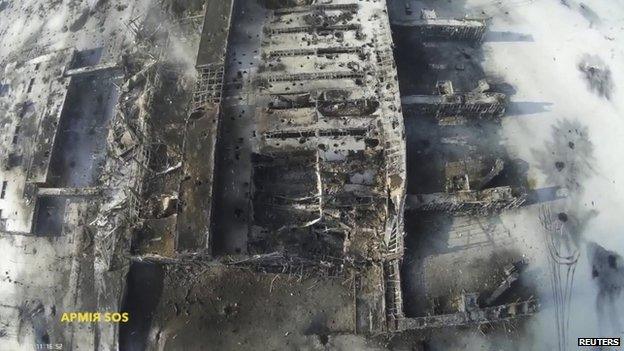
A drone image showed the damage to Donetsk airport
Even before the airport had been captured, Ukraine accused separatist forces of seizing more than 500 sq km (194 sq miles), mainly around Debaltseve and Mariupol.
Casualties on both sides have been heavy, and journalists say the separatists have suffered major losses.
Ukrainian forces made significant gains last summer, many of which have not been reversed.
The separatists opened up a coastal front by the Sea of Azov before the September ceasefire, moving within range of the port city of Mariupol, but the ultranationalist pro-government Azov battalion recaptured some villages outside the city in early February.

Why did the fighting start in the first place?
In April 2014, pro-Russian activists seized control of government buildings in towns and cities across the Donetsk and Luhansk regions.
The events were a repeat of what had happened in Ukraine's Black Sea peninsula of Crimea.
.jpg)
Across eastern Ukraine, pro-Russian separatists moved into government buildings in April
Gunmen there seized government buildings in February 2014 and raised the Russian flag a week after elected President Viktor Yanukovych, friendly to Moscow, fled during massive pro-EU street protests in Kiev.
An early attempt by nationalists to remove the status of Russian as a second language alarmed many Russian speakers, and officials in Moscow portrayed the new leaders in Kiev as US-backed Ukrainian nationalists bent on violating minority rights.
A flawed referendum on joining Russia was quickly held in Crimea and within a month the peninsula's annexation was complete.
There was little bloodshed in Crimea, but Ukraine's fledgling revolutionary government was in no position to fight back, with only 6,000 troops reportedly ready for combat.
However, when pro-Russian separatists made a move on Ukraine's industrial east and Russian forces appeared to be building up on the borders, the authorities in Kiev ordered an "anti-terrorist operation".
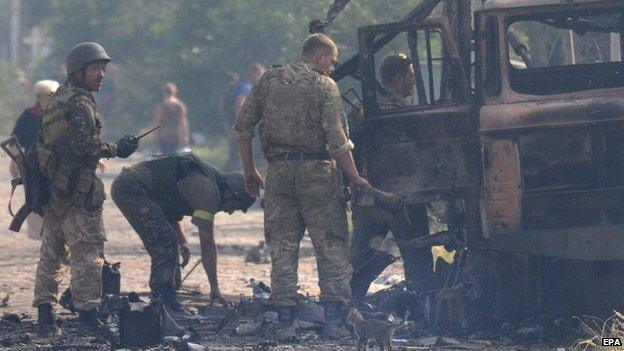
Ukrainian forces struggled to hold on to territory as rebels advanced on the coast of the Sea of Azov
